How to clean a bath?
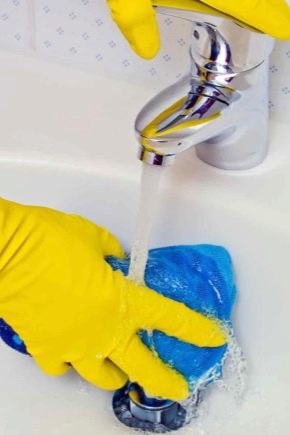
Even the best housewives are faced daily with the need to clean, wash, scrub or remove suddenly formed stains. This article will consider the phased cleaning of one of the main rooms in every home - the bathroom, and, in particular, the bathroom bowl itself.
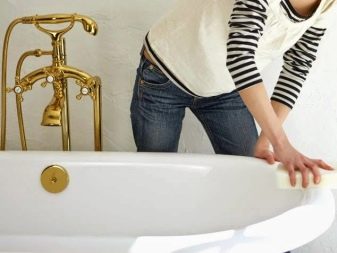

Kinds
To begin, consider the main types of plumbing from various materials and their brief characteristics.
According to the material of manufacture, the following types of bathtubs can be classified:
- Cast iron. Bathrooms made of this material are durable, so cast-iron bowls have the longest service life. They hold heat well and are resistant to high temperatures. It is very easy to care for such plumbing, as the enamel coating does not contain pores and is resistant to many chemical influences. The only negative is that the enamel can crack with a strong blow, and in this case it will be difficult to restore it.
- Steel. This type of bath is quite durable, light in weight and resistant to the formation of pollution. The heat capacity is small. But on steel baths, there are almost no stains from accidentally falling cigarette ash or a lit match (which cannot be said about acrylic ones). The enamel of such baths does not turn yellow.The main disadvantage is the same as that of cast iron ones: the enamel coating is not resistant to high force impacts.
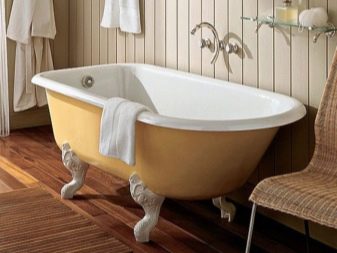
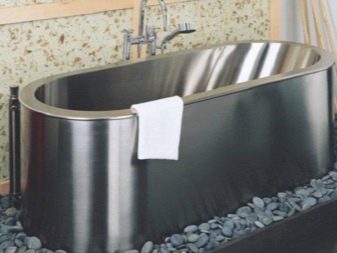
- Acrylic. The polymer material is highly ductile; if an object suddenly falls, the enamel will not crack. Also, with regular care, bacteria practically do not multiply on the acrylic surface. The water stays warm for a very long time. It is enough to rinse the bathroom after each use, and it will always be clean. Disadvantages can appear only with improper use of plumbing. Also, it does not withstand temperatures above 60 degrees.
- Cast and natural stone. Such bathtubs made of artificial and natural stone are durable and long-lasting. They are resistant to chemical influences, but they can only be cleaned with soft sponges and soap. They also require careful handling to prevent scratches.
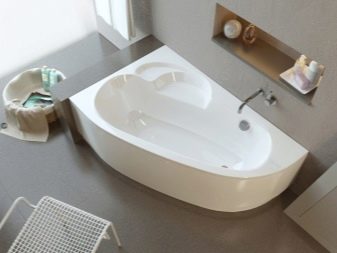
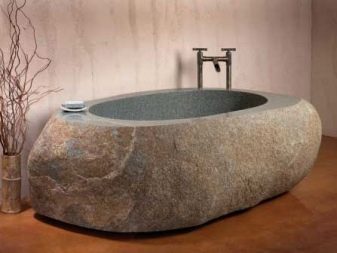
- Ceramic bathtubs are durable, resistant to scratches, bacteria and stains. They are easy to clean by any means, since the ceramic-metal coating is resistant to any chemical attack, including constant contact with poor quality tap water. The most tangible drawback is their fragility in case of improper and careless handling.
- Bathtubs made of modern materials (xonix, kvaril) have almost the same characteristics as acrylic and ceramic bathtubs in terms of surface care.
- With hydromassage. Bathtubs of this type are made from different materials. The massage effect is achieved with the help of nozzles, from which either air bubbles or water jets, or a combination of both, enter the container.
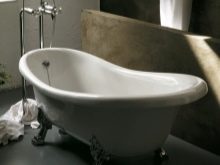

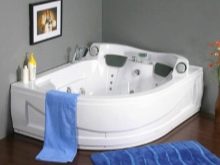
Effective cleaning methods
It is not always enough time and energy to monitor the cleanliness of the bath every day.Often it is used for other purposes. In it, they wash, wash animals, soak linen, wash shoes and large items. It should be noted that cleaning white acrylic bathtubs requires specially selected products due to the specific coating.
But first, let's look at all the types and causes of pollution that can occur on the surface of the bathroom for a long time:
- limescale. It occurs due to hard tap water, which contains magnesium and calcium salts - it is they, when they get on the surface of the bath, that form ugly whitish stains, depriving it of a radiant sheen. Therefore, this type of pollution is best washed with acid-containing products.
- Rust. Appears due to the increased content of iron in the water. Most often in places of constant contact with water - at taps, drain holes and next to them. Yellow rust stains are difficult to clean off.
- Yellowness on bathroom enamel and other bathroom items due to dirty piping. Flowing through it, the water carries various acids that settle on the surfaces, forming a plaque.
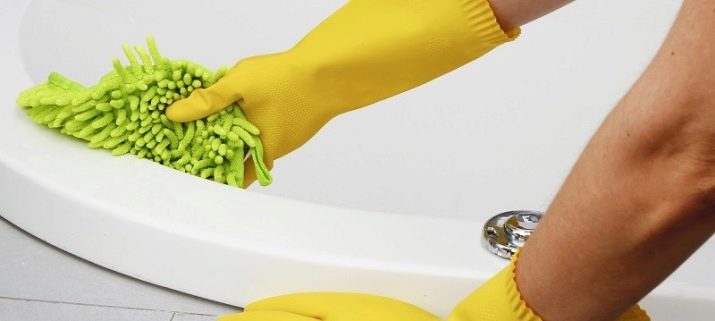
- Special types of pollution. These contaminants are the result of repairs, careless handling of coloring substances: potassium permanganate, iodine, brilliant green, hair dye, coloring balms, blueberry juice. Also, these types include smoldering cigarette ash and mold.
- Soapy plaque. It is formed from constant contact with the chemical compounds of soaps, shampoos, shower gels.
- Plaque. It is a combination of particles of skin, fat, sweat washed off the human body with soap suds and forms a kind of "flake".This build-up can be easily dealt with if you regularly clean the bathroom after each wash with a warm shower jet and a soft cloth with a little dishwashing detergent or laundry soap.
- Old enamel surface. Such enamel is covered with microcracks, into which various contaminants constantly get, which makes the bathtub look unkempt. In this case, washing the bath will not be easy, but possible.
If all the household chemicals in the house are over, ordinary citric acid can be used to speed up the cleaning of the container. The process itself will take about half an hour. This is the exposure time of the product on the surface of the bath.
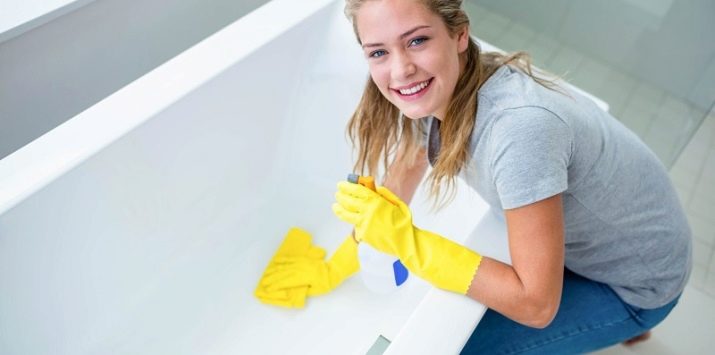
To prepare it, in an enameled or plastic container, you need to mix two tablespoons of dry citric acid crystals (about one bag), which any housewife has, and 0.5 liter water. Then apply the solution with a soft sponge over the entire surface, after closing the drain device. Hands must be protected with gloves. You can also cover the bath with napkins soaked in an acid solution. When the exposure time has passed, simply rinse it with water. Citric acid removes yellow and limescale well. If necessary, the procedure can be repeated as many times as necessary.
If the bath is very dirty, then you can also wash it quickly to a snow-white state at home. But this will take a little more time, because the work will have to be carried out in several stages.
First you need to prepare a special gruel. To do this, mix ordinary baking soda and soda ash in equal proportions. Then dilute the mixture with a little water until a semi-liquid paste is formed. Baking soda is available in every kitchen, and soda ash can be purchased at a hardware store or home improvement department. This is the easiest cleaner ever.

Then you should abundantly moisten the walls and bottom of the bathtub with water and evenly apply the prepared composition with a soft sponge. After 10 minutes, without rinsing anything, apply a mixture of vinegar and bleach. These ingredients are also taken in equal proportions. You can take the most common vinegar, table vinegar, 9%. Bleach - "Persol", Ace, "Bos", "Whiteness", Vanish and other powdered bleaches that can be purchased at any store at a low price. Leave for half an hour.
Then, with a sponge, wipe the entire bath and rinse thoroughly with water. When working with vinegar, it is better to protect the face with a cotton-gauze bandage. After such cleaning, even the dirtiest bath will shine with cleanliness.
Acrylic
The material from which these bathtubs are made is a plastic polymer. In fact, it is a plastic with considerable hardness. Acrylic has a wide range of uses, including being used to make bathtubs.
Advantages of acrylic bathtubs:
- relatively low price;
- high heat capacity;
- non-slip surface;
- some models are available with an anti-slip coating (anti-slip);
- resistance to strong impacts;
- hygiene;
- ease of daily care;
- the possibility of restoration with their own hands;
- varied design.

Minuses:
- instability to chemical and high-temperature influences;
- scratches from any hard objects.
Also, one should take into account the fact that not every acrylic bath offered in stores at a low price will have all the advantages described in use. It may just be plastic or very poor quality acrylic that will fade after a week of active use.
Based on the above characteristics, we can conclude that acrylic bathtubs need special and thorough care. They are sensitive to any aggressive chemicals, so you can only use special cleaners for cleaning them, which do not include chlorine, acids, alkalis, alcohols, ammonia, formaldehydes, powder granules.
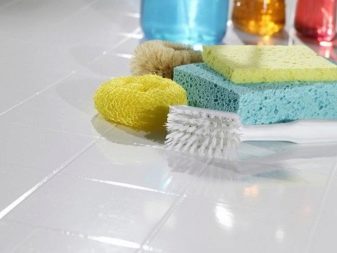

After each wash, wipe the entire surface dry. You can clean the bath using special creamy household chemicals no more than once every 2 weeks.
The most comfortable temperature is about 45 degrees, at a water temperature of 50-60 degrees and above, the walls and bottom of the bath can be deformed.
From mass-market products, you can use sprays and soft products for washing, polishing, cleaning from rust, water stone, and hygienic treatment. You can also find universal products that combine components that fight all types of pollution, for example:
- Ravak. A line of Czech-German products with a wide spectrum of action. It will help to wash off grease, water scale and especially strong dirt without damaging the acrylic. This is an expensive imported product.
- Triton Acrylic cleaner. A relatively new product for acrylic, plastic and chrome surfaces from a domestic manufacturer. The composition includes water, PVA 5%, organic acids, antiseptics. Removes grease, limescale, rust. After application, the bath will shine. It is easily sprayed on the surface of the bath, the product is left for 10 minutes, then washed off with a sponge. The cost is average.
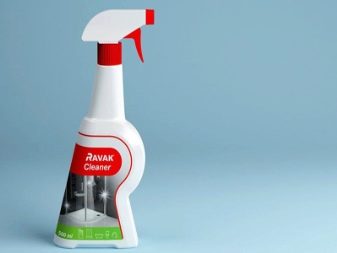
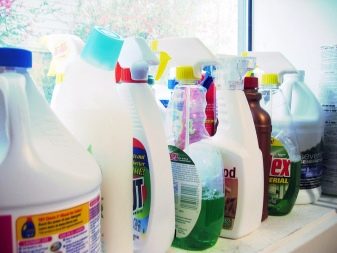
- "Acrilan". The composition of the product includes citric acid and surface-active chemicals (surfactants), which are not harmful to the acrylic surface. It has a cleaning and disinfecting effect. Also suitable for sanitary ware, bathroom tiles and glass. It has a convenient spray gun that allows you to spray both foam and liquid jets. The tool is fast-acting, you need to wash it off almost immediately after application. Do not leave it until completely dry. Forms a protective film on acrylic that prevents the formation of plaque and rust. Of the minuses of the product, its unpleasant odor and relatively high price can be noted.
- cif. Inexpensive affordable creamy product that is suitable for acrylic. The composition does not have strong abrasive components, easy to use, cleans various surfaces. Of the minuses - does not remove persistent dirt.
- Bass. Disinfectant and cleanser in the form of a gel. The composition contains weak acids, so it is better not to leave the product on the surface for a long time. You can use it only on problem areas, wiping with a soft sponge after application, then rinse with water.
- Frosch. A natural product based on tartaric acid, which can be sprayed on the surface of the bath, while protecting the hands with gloves. The exposure time is from 10 to 20 minutes depending on the pollution. Suitable for families with children and allergy sufferers.
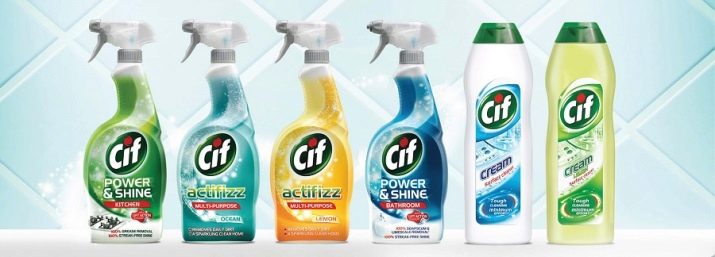
- "Mr Chister" The composition of the product includes non-ionic surfactants 5%, citric acid, antibacterial components, acrylic copolymer, sodium citrate. Spray bottle with dispenser. The maximum exposure time is 2-3 minutes, after which you need to wipe with a soft cloth and rinse with plenty of water. Of the minuses - a pungent smell. You also need to work while protecting your hands.
- L.O.C. Amway. The product does not contain abrasives, it does not contain acids and chlorine, so it is suitable for people with allergies to chemicals. The tool copes well with pollution, it is economically consumed. Of the minuses - a rather high price.
- Folk remedies. Acrylic bathtubs can be cleaned using table vinegar or citric acid. But the concentration must be very small. It is better to fill the bath and dissolve a small amount of vinegar or citric acid in it and leave it for 10-12 hours. The concentration of vinegar is 1: 50 or 0.5: 50. Then drain the water and rinse the bath with water, then wipe dry.
You can also simply wipe the surface with lemon juice or make a “cream” at home by mixing soap chips swollen in water with a small amount of soda and a drop of essential oil.
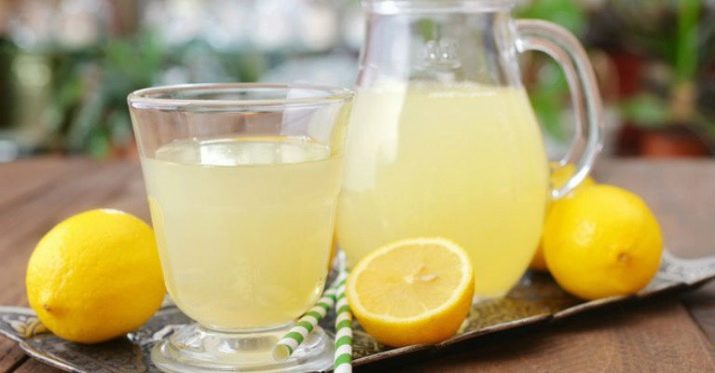
When cleaning acrylic baths, do not use hard and especially metal sponges, brushes with unnatural bristles and any abrasive materials.
Do not soak laundry in acrylic baths, as hard parts can damage it, and bright fabrics can shed and stain the surface. If you need to wash by hand, you need to put a rubber or silicone mat on the bottom of the tub, which will prevent the basins from scratching the bottom. You can not bathe animals for the same reasons - the surface can be damaged by their claws.
If scratches and plaque still appear and they cannot be polished with felt, you can purchase special liquid acrylic for do-it-yourself repairs. Such acrylic can be bought in a special kit for the restoration of acrylic bathtubs. Instructions are included with it. The substance is applied to the surface of the bath, evenly distributed, after a while the polishing process is carried out manually.

Cast iron and steel
The enamelled coating of cast iron and steel bathtubs is a material that includes glass. Such surfaces tolerate an alkaline environment worse than a solution of weak acids. Therefore, if the bathtub enamel has faded, the care product was chosen incorrectly.
Cast iron and steel containers, as well as acrylic ones, should be washed after each use and then wiped dry to keep the surface smooth and shiny. If there is no strong pollution, it is enough just to rinse the surface with warm water from the shower.

It should be noted that old and new bathtubs are not recommended to be cleaned with chlorine, harsh abrasives and acids, nor can they be washed with compounds that are produced for bathrooms.
Folk cleaning methods at home were discussed above, and as for the mass market, here you can select soft products for periodic cleaning and those that include chemically active components to remove stubborn dirt. Among them are:
- "Sanoks Gel" of the company "Aist" - it contains oxalic acid, so it can wipe off the most old rust stains, but it can not be used regularly, as this acid spoils the enamel over time.
- Cilli Bang - a means for regular washing of the bath, but it is better to deal with water stone and rust in other ways.
- Cif "Ultra White" - gel cleaning and bleaching agent.
- Comet "7 Days of Purity" - universal gel for bath, plumbing and kitchen. Removes heavy dirt.
- "Pemolux soda 5". A proven product made from soda and marble chips, suitable for old cast-iron bathtubs.
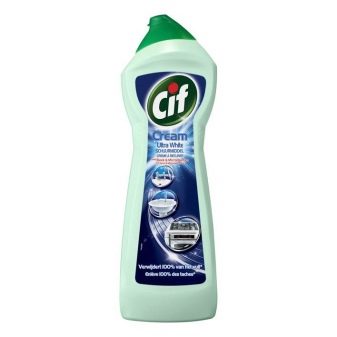
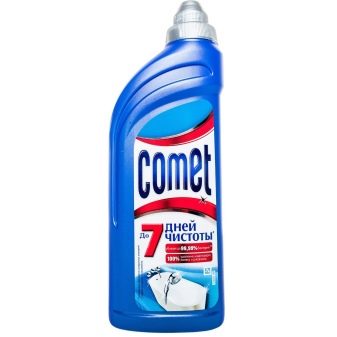
With hydromassage
Such baths are most often made of acrylic, it is more plastic and cheaper than artificial and natural stone.
A special pump pumps water from the bath, then it passes through nozzles (jets) - round holes on the surface, and again comes out in jets, creating a massage effect. Jets accumulate bacteria and mold over time.
It is enough to wash the container regularly with special products without abrasives that are suitable for acrylic. It is also necessary to clean the entire hydromassage system regularly, after each wash. Not all bathtubs have automatic disinfection, so you need to wash the nozzles from dirt yourself. To do this, pour a full bath of water and pour disinfectant into it, then turn on the system. After some time required for cleaning, it must be turned off, the water drained. Then take a bath again and turn on the hydromassage for 5-10 minutes to wash off the remnants of the product.
If the system is still dirty, then you can clean it in the same way with the addition of a dishwasher cleaning tablet along with a disinfectant.

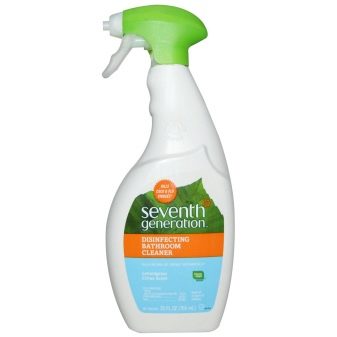
Home remedies and formulations
If there is enough time to clean the bath, you can use one of the many different folk remedies. The choice of method and means of cleaning the bath should be determined by the type of stain or plaque, the degree of contamination and the material from which its bowl is made.
The main remedies for stubborn dirt that are in every home:
- soda (food and soda);
- vinegar;
- lemon acid;
- salt;
- laundry soap solution;
- ammonia (gives shine to enameled surfaces);
- dishwashing liquid;
- hydrogen peroxide;
- cream of tartar;
- Coca Cola.
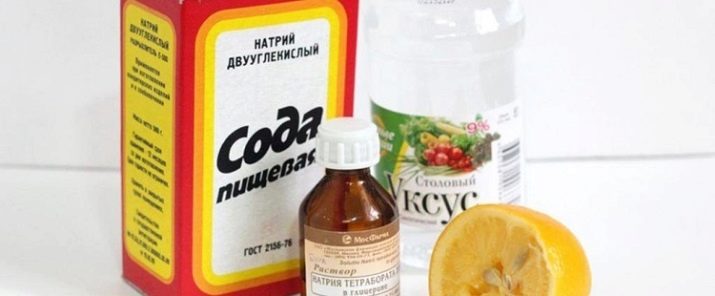
To make the bathtub shine, you can clean it with vinegar alone, soaking paper napkins in it beforehand.They should be laid out on the surface of the bath and left for several hours. This method is suitable for relatively new bathtubs. The enamel will become much whiter.
It is also recommended that after this procedure, treat the container with a solution of soda to restore the acid-base balance.
Rusty spots and yellow deposits can be removed with a mixture of wine vinegar and coarse salt. To do this, mix 100 milliliters of vinegar and a tablespoon of salt. Heat the mixture to 65 degrees and apply it on the stain, leave for 20-30 minutes. Then rinse with water. Table salt can be used in combination with turpentine. The mixture does not need to be heated. Just apply for 20-30 minutes on a rusty surface, then rinse with water.
Stubborn rust stains can also be cleaned with hydrogen peroxide. This liquid has no color, and the peroxides contained in it do an excellent job of removing yellow plaque.
To effectively remove limescale and give a shiny surface, you need to mix 150 milliliters of ammonia and 50 milliliters of hydrogen peroxide. Leave this mixture in a glass container for 10 minutes. Next, moisten the sponge with the product and intensively wipe the entire bath using gloves and a bandage for the face. Then rinse with a stream of water. This composition will give the bath a radiant shine.

Red stains can be removed with a mixture of cream of tartar, hydrogen peroxide and any mild detergent. Cream of tartar is used in cooking to make pastries and mousses, and the acidic potassium salt it contains is suitable for bath cleaning. You need to take 300 grams of a mild cleaning agent, 70 milliliters of hydrogen peroxide and 5 grams of cream of tartar. Use the mixture to treat only places of strong pollution. Leave no more than 30 minutes.Such a product is best stored at a low temperature in an airtight container.
A solution of laundry soap and a few milliliters of ammonia will help wash all kinds of stains. Also, soap shavings dissolved in water can be used with baking soda to remove limescale.
Coca-Cola contains carbonic acid. This drink does not have an unpleasant odor and does not irritate the skin, so you do not need to protect your hands and face. Coca-Cola helps to cope with limescale, remove rust from the surface of the sink, bathtub, bathroom and tiles, as well as faucets and taps. It is very simple to do this - you need to moisten a soft cloth or sponge with this drink and wipe the surface. If necessary, repeat the procedure. Plaque from the bathroom can be cleaned like this: pour the drink inside and close the toilet lid on top. After an hour, just clean it with a brush.

The rust bath can be cleaned with towels soaked in sparkling water. They need to be laid out in places where rust accumulates and left for two hours, periodically additionally wetting the fabric with a drink. Coca-Cola can also be used to prevent blockages in the pipeline.
Helpful tips if unexpected contamination occurs:
- Potassium permanganate from the bath can be effectively washed with citric, acetic or oxalic acid at a concentration of 10%. You need to work carefully. The stain from potassium permanganate is poured with a solution for 5 minutes, then the place is thoroughly washed with water. Peroxide with acetic acid is also suitable. You need to mix them, apply on cotton wool and rub the stain. This remedy also removes old stains.
- You can try cleaning the bathtub enamel from blueberries with bleach mixed with washing powder, which is applied to a sponge and rubbed into the stain, then washed off with water.
Room cleaning features
Having coped with cleaning the bath, you can proceed to the rest of the plumbing and accessories. A polyester bath screen needs to be washed regularly. You need to wash them on a delicate cycle in a washing machine without spinning. Then they can be dried by hanging in the bathroom.
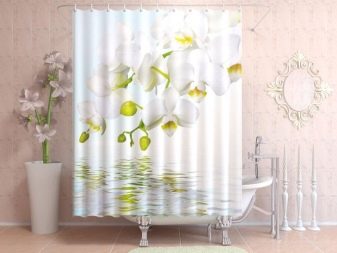
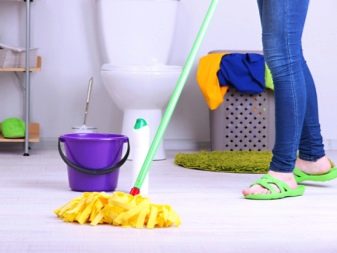
Glass surfaces need to be cleaned with special sprays that will remove grease and plaque. Then wipe thoroughly with dry newspaper/paper.
Ceramic tiles can be cleaned with a solution of vinegar and water, then wipe the grooves with chalk. The second option is to wipe it with a damp cloth, on which soda and crumbled chalk are poured.
Tiles are best washed with a brush with natural soft bristles. Matte floor tiles, which have an anti-slip coating, are washed with special emulsion products, and then rubbed with a color-maintaining agent, glossy tiles should be wiped with vinegar or ammonia for shine and brightness.
Nickel-plated faucets and surfaces can be stained by wiping them with a weak solution of citric acid or just a lemon peel.
After the walls and floors have been cleaned, they should also be dried with a microfiber cloth, fluffy towel or bamboo cloth.
The ceiling in the bathroom can be cleaned with a vacuum cleaner or mop. If it is stretched and consists of plastic panels, then in order to wash it, it is not recommended to use abrasive sponges and products based on acetone, otherwise the surface will fade, stains will appear.
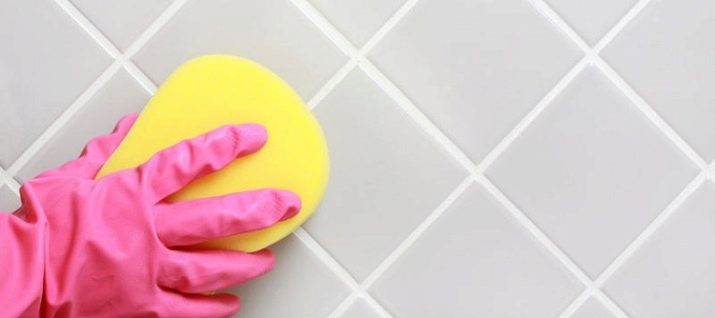
You need to wash the plastic ceiling on a stable ladder or platform. You will also need a window mop, glass cleaning spray, a dry absorbent cloth, a soft sponge and a container of water.First, using a mop, you need to clean the ceiling of dust, then moisten the surface with a warm soapy solution or spray and gently wipe off all dirt, preventing the ceiling from drying out. Then wipe dry and remove moisture in the corners with a dry sponge.
If the ceiling panels are heavily soiled, you need to dismantle the entire structure and wash each panel separately, and then wash the frame, floor slab. Upon completion of the work, everything is installed in place.
How to wash after repair?
When installing a new bath, you can immediately install a special anti-lime filter, which will soften the water and prevent the formation of plaque.
Building dust will be easier to wash if you add a few tablespoons of vegetable oil to a bucket of warm water. This will quickly collect cement dust, dirt and small debris. After that, you need to wash the walls, floor and ceiling with a cleaning agent, then rinse and wipe dry.
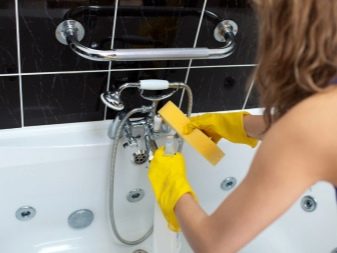

If there are stains on the tile, you can wipe them off with:
- a large amount of water;
- acetone, washes, then apply a fresh primer (if there are stains on the floor);
- rubber spatula or cloth (if the solution is fresh);
- solvent for epoxy resin;
- glue thinner or water with vinegar or ammonia.
Spots of paint on the tile can be washed off with a solvent applied to a piece of fabric. It is placed on a contaminated place and covered with a film. Then, after about half an hour, the swollen residues are removed with a spatula or rubbed with a dense rubber sponge.
Taps and faucets and showers can be washed with a soapy solution based on, for example, dishwashing gel. In no case should chrome-plated surfaces be washed with acid-containing products - stains will appear, plumbing will be damaged.
Strong smudges of paint can be removed from the surface of the bathtub mechanically - with a blade or a clerical knife, but this must be done very carefully so as not to scratch the metal.


Glue stains can be removed by pouring hot water into the tub. It must be left in the bath for 24 hours, and then gently scrubbed with the hard side of the sponge.
For information on how to wash a cast-iron bathtub from plaque at home, see the following video.






















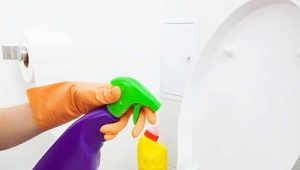
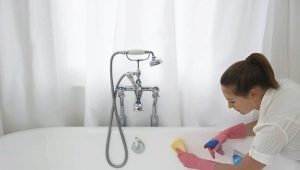




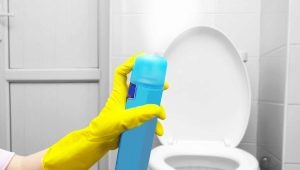
I have a whole arsenal of products for various pollution in the bathroom: with acid, and with chlorine, and with soda. During the entire period of use, there were no problems. At first I was only afraid that I would ruin the enamel, but everything worked out.